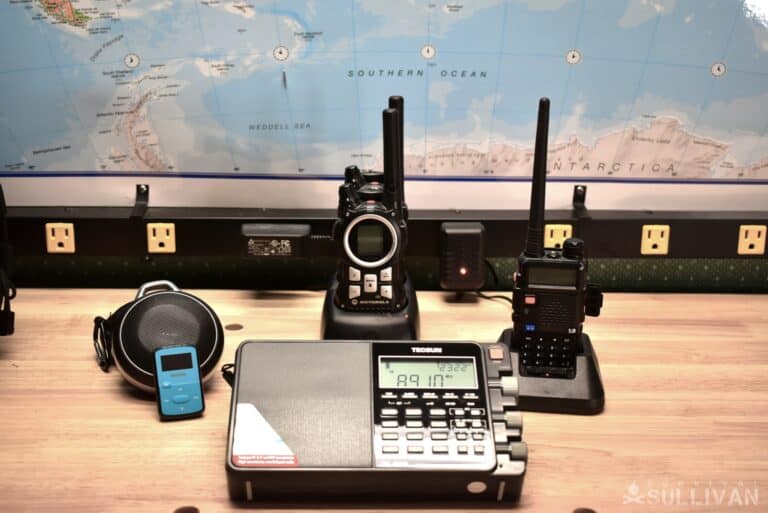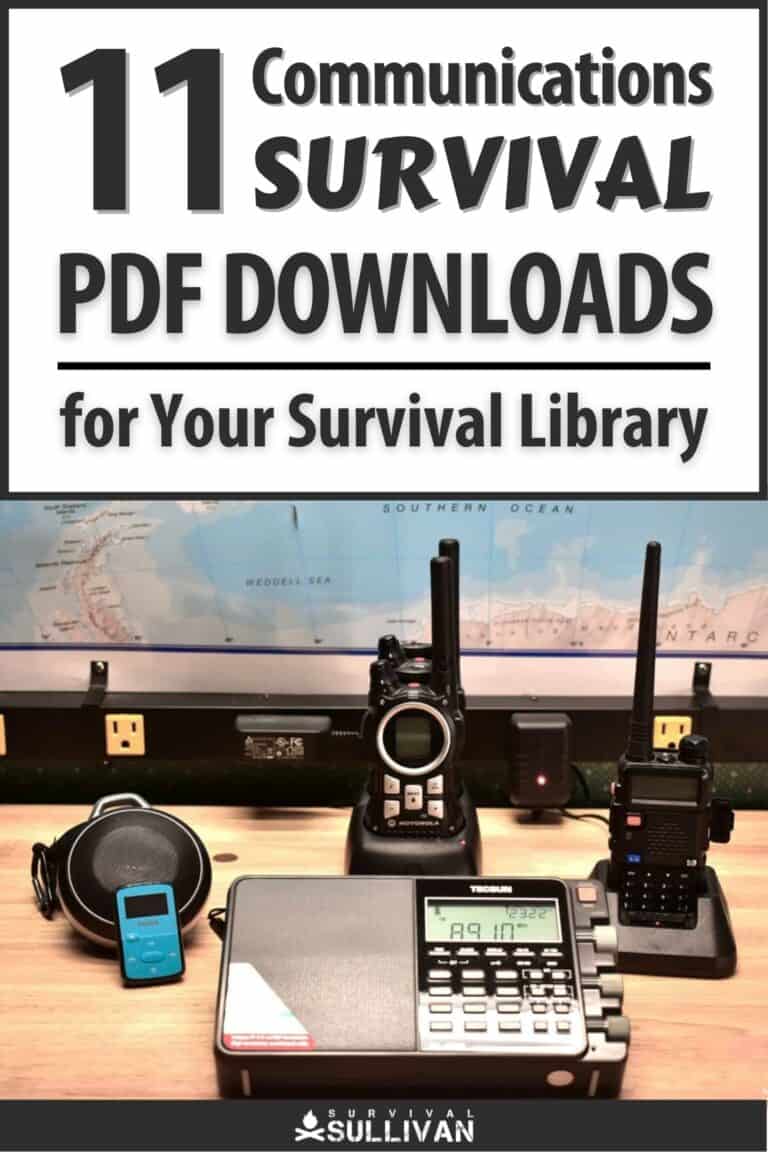To be a well-rounded prepper there are lots of skills you’ll need to learn, and regardless of what skills you have mastered already and which ones you have procrastinated on, it always pays to have a sizable library of reference material to learn from.

Whether you need to get your education underway properly, knock the rust off of an underutilized skill set or just track down a very particular piece of information, a good survival library is worth its weight in gold in any long-term survival scenario.
Communication skills are essential in our modern world, particularly considering that cell phones and internet utilities are comparatively fragile compared to a traditional two-way radio.
To help you brush up on your communication skills and start a new section in your survival library we are here with 11 downloads that will take you through all phases of radio operations and preparing an emergency communications plan for your family or your group. Let’s get going!
1. Two-Way Radio Protocol, California State University Domingo Hills
If you are unaccustomed to communicating on a traditional radio set, you might be surprised to learn that it is quite a bit different from utilizing a cell phone.
All radios, even the most advanced modern sets, have eccentricities that can make operation challenging and communicating effectively over the air difficult for the initiated and frustrating for those who are trying to talk to you.
You really do need to learn a new way of doing things when communicating via radio, and though it isn’t nearly as hard as learning a new language it has its own set of manners; etiquette, as it were.
This, thankfully, is easy to learn, and even if you learn nothing else this can make your use of a radio much smoother and quicker when minutes count.
This download from California State University is an excellent, short primer on basic radio etiquette, operation and the most used terms.
If you don’t know anything else, start with this one. Download it here.
2. Glossary of Ham Radio Terms
When discussing or reading about any of the other literature on this list, or anywhere else, about radio communications it might look like English but you still can’t understand it.
This is because radio comms, both discussions of hardware and practice, rely upon an awful lot of jargon and terminology to get across concepts easily and with a minimum of effort.
Accordingly, it is time to break out the glossary. We’ve got one for you today that is nearly 20 pages of the most commonly used ham radio terms.
Not all of them are useful on an everyday basis, and all of them will apply to your specific radio, but they will all help you make sense of everything else you’re going to read throughout the rest of the downloads we have for you today.
Mastering these terms will greatly speed up your learning and help you sound like an old pro in conversation. Get it right here.
3. Morse Code Charts, Ary Boender
One of the most fundamental forms of visual, auditory, and radio communication is done through Morse code.
Using a simple binary combination of dots and dashes (or dits and dahs) letters and numbers can be rendered and through combinations of those entire words and eventually sentences.
It is also used to facilitate shorthand commonly known between seasoned radio ops.
Like any code or language, it requires practice and one of the best ways to practice is by constructing your own words and sentences with a handy reference close at hand to check your work.
It sounds simple enough, but this chart goes way beyond the fundamentals and features Morse code for many languages, not just English.
This is a great reference to have for seasoned and starting radio operators alike. Snag the chart here and keep a laminated copy close to your set.
4. The Amateur Radio Handbook, ARRL
Although it is one of the oldest forms of electronic communication, radio technology, like all other forms of technology, constantly marches forward.
Therefore you might think it kind of strange to include this ARRL radio amateur handbook from 1968.
Though dated, it is more than just an interesting historical piece. The fundamentals and concepts contained within are as valuable now as they were back then when it was first printed.
The diagrams along with the technical overviews of older radio sets can be a godsend if you are trying to fix or restore your components.
Considering just how many older sets are still out there in the world, this manual might be the key to getting one working when you need the most.
Link to download.
5. Antennas Made of Wires Vol.3, L.B. Cebik
One of the most important parts of any radio set is the antenna. For receiving and transmitting alike, the shape and configuration of your antenna will greatly influence the performance of your radio in various conditions.
Understanding the characteristics and performance envelope of a given antenna is it fundamental to maximizing your performance with the radio.
This book is a volume that represents a cross-section of the collected works of L.B. Cebik, and though most of it will read like Greek to beginners once you have a fundamental understanding of radio theory and it signals behavior it will start to make a lot more sense.
Consider that you might have to repair, replace or improvise an antenna in the aftermath of a major disaster and you’ll start to see why you need this book.
Even if you don’t need it right now in your journey with radio communications, it is a great reference to have. Get it here.
7. Stealth Amateur Radio, Kirk A. Kleinschmidt
Your radio usage is not necessarily your business alone. The federal government is keenly interested in the activities of amateur radio users in the civilian world, and regulations abound for all sorts of things.
Furthermore, getting the most from any radio set might entail interfering with other signals in the world that could be to the detriment of your neighbors or attract the wrong kind of attention…
In short, it is all theory until you can put it into practice in a way that does not paint a bullseye on you, socially or otherwise.
This wonderful book, Stealth Amateur Radio by Kirk A. Kleinschmidt is a terrific practical source for getting the most out of your radio in all sorts of circumstances in and around society, while keeping your business your business.
We already live in an increasingly invasive surveillance state, and radio is far more vulnerable to surreptitious location and eavesdropping than other forms of electronic communication.
From stealthy antenna setups to spoofing attempts at locating your shack, this book has it all and is written in an easy conversational way that makes it extremely interesting for beginners and experts alike.
This is a must-have for preppers. The entire book is right here.
8. Radio Operators Handbook MCRP 3-40.3B, U.S. Marine Corps
Radio communication is intrinsic to military operations at all levels, and perhaps nowhere is it more important than for the infantry.
Naturally, the United States Marines have this down to a science and you can learn from the sum of their knowledge and expertise using the same handbook that they rely on to train their radio operators for field conditions.
This handbook is packed with a surprising amount of theory, tips, tricks, and problem-solving techniques for the most common man-portable radio set used in the marines, but the advice applies to radio usage in general.
This is one of the very best free resources once you have the basics under your belt. Get it here.
9. Community Emergency Response Communications, FEMA.
Communications isn’t all about radio, but radio factors heavily into a well-developed and robust emergency communications plan.
Establishing this plan with your family, survival group and even your neighbors in the community can greatly accelerate response and relief efforts for all kinds of disasters.
This guide from FEMA will give you a “ground floor” view of what emergency response communications planning looks like, how to integrate various forms of communications from radio to internet all the way down to human runners, with the advantages and disadvantages, and how to establish meaningful command and control to handle problems and best direct efforts.
Complete with wonderful examples of multi-team communications, some role-playing exercises, and lots of practical information gleaned from hard experience, this is a must-have for families and MAGs. Download it here.
10. Disaster Preparedness Supplemental Communications Planning
This is another excellent guide that is packed full of practical problem-solving guidance and examples are taken from real-world emergencies and disasters when it comes to using personal radio service and other radio services.
The expertise and experience shown are really something, and this provides an excellent overview of the various civilian accessible radio bands, their advantages, disadvantages, and specific considerations for use in the aftermath of a disaster.
For instance, CB radio, long thought to be the most accessible and affordable band for civilians, is in all likelihood going to be completely useless in the aftermath of a disaster since it has been completely overtaken by illegal hobbyists making use of power amplifiers to talk over a great distance, greater than what was intended with the creation of the band!
If you were going to rely on CB after a major disaster, you’ll find it basically jammed.
A much better choice, according to the authors, for families would be FRS or GMRS. The depth and breadth of the insights for each is highly interesting even if you aren’t a pro at using radio and readily understood even by beginners.
Make this document foundational to your planning, especially if you are setting up communications for a group or your community.
Get it here.
11. FRS/GMRS Transceiver List
Last but not least, we have a frequency and channel chart list for FRS and GMRS transceivers in the United States.
This is a handy guide that can show you what frequencies you can use with your applicable radio service and the restrictions on the maximum permitted power allowed for transmission.
This is useful both for remaining legal but also for planning around high traffic frequencies and potentially high use times of the day. 1 page, get it here, and make sure to check back every now and then for updates.


Tom Marlowe practically grew up with a gun in his hand, and has held all kinds of jobs in the gun industry: range safety, sales, instruction and consulting, Tom has the experience to help civilian shooters figure out what will work best for them.

There are so many documents, books, guides, etc., telling you how to communicate, but for the most of us, all youcan do without a license is to listen, and it’s even the first thing you should be doing.
Besides ham radios, there is AM (500 – 1700kHz) and the 10-15 bands of shortwaves bands (3000kHz to 30,000 kHz!) It would be a good idea to know where on the shortwaves you would want to tune to listen for information, or intel, so you will hear instructions for which other radio(s) to turn on, and where to tune on that radio.